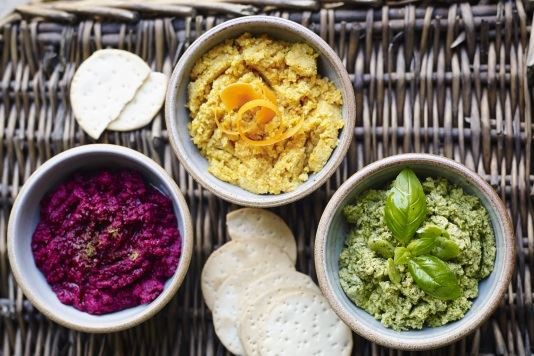Grow and cook: beetroot, broad bean and carrot hummus

Grow these easy plants and then use them to make moreish hummus.
Impress your friends with deliciously different types of hummus. Broad beans, carrot and beetroot make colourful, nutritious and delicious alternatives to the traditional dish.
The broad bean variety has no chickpeas so perhaps it is more of a dip! Either way, they are all easy to make and are perfect seasonal treats. These vegetables are easy to grow too, so even if you don't fancy using them to make them hummus they're worth a try. The beetroot variety is bolt-resistant so it can be sown early.
If you don't have space to grow your own, skip to the recipes below for a list of ingredients and instructions on how to make these delicious dips.
For the growing, you will need:
- 1 x packet of broad bean The Sutton seed
- 1 x packet of carrot Caracas seed
- 1 x packet of beetroot Moneta seed
- 1 x 50cm/20-inch diameter container
- Multipurpose or soil-based compost
- General organic vegetable fertiliser
How to grow your veg
Sow in early spring
1. Choose a sunny, sheltered spot for the container. It is a good idea to divide the surface of the compost/fertiliser mix into three sections, one for each vegetable variety.
2. Sow three broad bean seeds in a triangular shape, with one seed at each point, about 20cm/8 inches apart and at a depth of about 5cm/2 inches. Thinly scatter the carrot seed (Caracas is a short-rooted, Chantenay type) and cover with a 1cm/½-inch layer of sieved soil or vermiculite.
3. Beetroot may be sown a little deeper, at 2cm/¾ inches, and as the seeds are bigger you can make individual sowing holes with a pencil or the tip of a dibber and sow two seeds in each one. Try to space them about 7–10cm apart but, as with all container vegetables, it is fine if they are a bit more snug.
4. Once the carrot seedlings are large enough to handle, thin them, to ensure that they have sufficient room to grow, to 7–10cm apart. The earlier you can do this the better, because the dreaded carrot fly is attracted by the scent of bruised leaves, which can be caused by thinning.
However, there is a school of thought that container-grown carrots do not suffer so much because they are off the ground (carrot fly can only strike up to 60cm/2ft above ground level). Remove the weakest beetroot seedling from each sowing position when they reach about 5cm tall.
5. In cool areas, protect the bean and carrots seedings from frost until after mid-spring. Water the container well and apply a balanced liquid fertiliser every two weeks (this carrot variety can stand a little more watering and feeding than other varieties, without forking).
6. The Sutton is a dwarf broad bean, so will not need staking. When the first beans appear, pinch out the growing tips to encourage other pods to set, to keep the beans tender and to deter blackfly.
Time to harvest
From midsummer, when bean pods are well filled and the beans are still soft, the carrots are sweet and crunchy and the beetroot are a little bigger than golf ball-size and tender.
The recipes
Once you've harvested your crop, head to the kitchen to make:
You might also like:
Broad bean and almond hummus and smoked aubergine dip recipe
Comments
Be the first to comment
Do you want to comment on this article? You need to be signed in for this feature